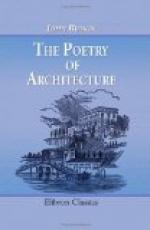[Footnote 20: In the large buildings, that is: [Greek: keramos] also signifies earthen tiling, and sometimes earthenware in general, as in Herodotus iii. 6 [where it is used of earthen jars of wine.] It appears that such tiling was frequently used in smaller edifices. The Greeks may have derived their flat roofs from Egypt. Herodotus mentions of the Labyrinth of the Twelve Kings, that [Greek: horophe de panton touton lithine], but not as if the circumstance were in the least extraordinary [Herodotus ii. 148.]]
127. Now, where the roof was thus a place of frequent resort, there could be no more useful decoration than a balustrade; nor one more appropriate or beautiful than occasional statues in attitudes of watchfulness, expectation, or observation: and even now, wherever the roof is flat, we have an idea of convenience and facility of access, which still renders the balustrade agreeable, and the statue beautiful, if well designed. It must not be a figure of perfect peace or repose; far less should it be in violent action: but it should be fixed in that quick, startled stillness, which is the result of intent observation or expectation, and which seems ready to start into motion every instant. Its height should be slightly colossal, as it is always to be seen against the sky; and its draperies should not be too heavy, as the eye will always expect them to be caught by the wind. We shall enter into this subject, however, more fully hereafter. We only wish at present to vindicate from the charge of impropriety one of the chief features of the Italian villa. Its white figures, always marble, remain entirely unsullied by the weather, and stand out with great majesty against the blue air behind them, taking away from the heaviness, without destroying the simplicity, of the general form.
128. It seems then that, by its form and details, the villa of the Lago di Como attains so high a degree of elevation of character, as not only brings it into harmony of its locus, without any assistance from appearance of antiquity, but may, we think, permit it to dispense even with solidity of material, and appear in light summer stucco, instead of raising itself in imperishable marble. And this conclusion, which is merely theoretical, is verified by fact: for we remember no instance, except in cases where poverty had overpowered pretension, or decay had turned rejoicing into silence, in which the lightness of the material was offensive to the feelings; in all cases, it is agreeable to the eye. Where it is allowed to get worn, and discolored, and broken, it induces a wretched mockery of the dignified form which it preserves; but, as long as it is renewed at proper periods, and watched over by the eye of its inhabitant, it is an excellent and easily managed medium of effect.




